《市场营销学》课程授课教案(双语)Chapter 5 Consumer Markets and Consumer Buyer Behavior
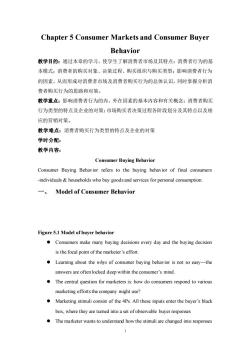
Chapter 5 Consumer Markets and Consumer Buyer Behavior 教学目的:通过本章的学习,使学生了解消费者市场及其特点:消费者行为的基 本模式:消费者的购买对象、决策过程、购买组织与购买类型:影响消费者行为 的因素,从而形成对消费者市场及消费者购买行为的总体认识,同时掌握分析消 费者购买行为的思路和对策。 教学重点:影响消费者行为的内、外在因素的基本内容和有关概念:消费者购买 行为类型的特点及企业的对策:市场购买者决策过程各阶段划分及其特点以及相 应的营销对策。 教学难点:消费者购买行为类型的特点及企业的对策 学时分配: 教学内容: Consumer Buying Behavior Consumer Buying Behavior refers to the buying behavior of final consumers -individuals&households who buy goods and services for personal consumption. 一、Model of Consumer Behavior Figure 5.1 Model of buyer behavior Consumers make many buying decisions every day and the buying decision is the focal point of the marketer's effort. Leamning about the whys of consumer buying behavior is not so easy-the answers are often locked deep within the consumer's mind. The central question for marketers is:how do consumers respond to various marketing efforts the company might use? Marketing stimuli consist of the 4Ps.All these inputs enter the buyer's black box,where they are tumed into a set of observable buyer responses The marketer wants to understand how the stimuli are changed into responses
1 Chapter 5 Consumer Markets and Consumer Buyer Behavior 教学目的:通过本章的学习,使学生了解消费者市场及其特点;消费者行为的基 本模式;消费者的购买对象、决策过程、购买组织与购买类型;影响消费者行为 的因素,从而形成对消费者市场及消费者购买行为的总体认识,同时掌握分析消 费者购买行为的思路和对策。 教学重点:影响消费者行为的内、外在因素的基本内容和有关概念;消费者购买 行为类型的特点及企业的对策;市场购买者决策过程各阶段划分及其特点以及相 应的营销对策。 教学难点:消费者购买行为类型的特点及企业的对策 学时分配: 教学内容: Consumer Buying Behavior Consumer Buying Behavior refers to the buying behavior of final consumers -individuals & households who buy goods and services for personal consumption. 一、 Model of Consumer Behavior Figure 5.1 Model of buyer behavior ⚫ Consumers make many buying decisions every day and the buying decision is the focal point of the marketer’s effort. ⚫ Learning about the whys of consumer buying behavior is not so easy—the answers are often locked deep within the consumer’s mind. ⚫ The central question for marketers is: how do consumers respond to various marketing efforts the company might use? ⚫ Marketing stimuli consist of the 4Ps. All these inputs enter the buyer’s black box, where they are turned into a set of observable buyer responses ⚫ The marketer wants to understand how the stimuli are changed into responses
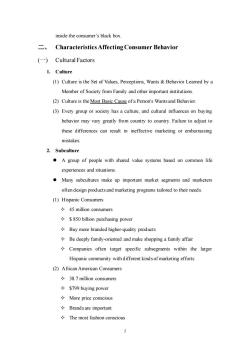
inside the consumer's black box. 二、 Characteristics Affecting Consumer Behavior ()Cultural Factors 1.Culture (1)Culture is the Set of Values,Perceptions,Wants&Behavior Learned by a Member of Society from Family and other important institutions (2)Culture is the Most Basic Cause of a Person's Wants and Behavior. (3)Every group or society has a culture,and cultural influences on buying behavior may vary greatly from country to country.Failure to adjust to these differences can result in ineffective marketing or embarrassing mistakes. 2.Subculture A group of people with shared value systems based on common life experiences and situations. Many subcultures make up important market segments and marketers often design products and marketing programs tailored to their needs. (1)Hispanic Consumers ◆45 million consumers $850 billion purchasing power Buy more branded higher-quality products Be deeply family-oriented and make shopping a family affair Companies often target specific subsegments within the larger Hispanic community with different kinds of marketing efforts. (2)African American Consumers 38.7 million consumers ◆$799 buying power ◇More price conscious ◇Brandsare important The most fashion conscious
2 inside the consumer’s black box. 二、 Characteristics Affecting Consumer Behavior (一) Cultural Factors 1. Culture (1) Culture is the Set of Values, Perceptions, Wants & Behavior Learned by a Member of Society from Family and other important institutions. (2) Culture is the Most Basic Cause of a Person's Wants and Behavior. (3) Every group or society has a culture, and cultural influences on buying behavior may vary greatly from country to country. Failure to adjust to these differences can result in ineffective marketing or embarrassing mistakes. 2. Subculture ⚫ A group of people with shared value systems based on common life experiences and situations. ⚫ Many subcultures make up important market segments and marketers often design products and marketing programs tailored to their needs. (1) Hispanic Consumers 45 million consumers $ 850 billion purchasing power Buy more branded higher-quality products Be deeply family-oriented and make shopping a family affair Companies often target specific subsegments within the larger Hispanic community with different kinds of marketing efforts. (2) African American Consumers 38.7 million consumers $799 buying power More price conscious Brands are important The most fashion conscious
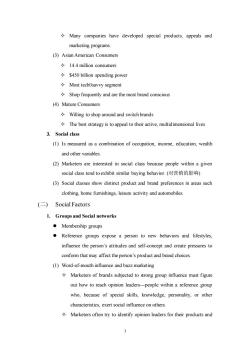
Many companies have developed special products,appeals and marketing programs. (3)AsianAmerican Consumers 14.4 million consumers $450 billion spending power Most techOsavvy segment Shop frequently and are the most brand conscious (4)Mature Consumers Willing to shop around and switch brands The best strategy is to appeal to their active,multidimensional lives 3.Social class (1)Is measured as a combination of occupation,income,education,wealth and other variables. (2)Marketers are interested in social class because people within a given social class tend toexhibit similar buying behavior.(对营销的影响) (3)Social classes show distinet product and brand preferences in areas such clothing,home furnishings,leisure activity and automobiles. (二)Social Factors 1.Groups and Social networks ◆Membership groups Reference groups expose a person to new behaviors and lifestyles. influence the person's attitudes and self-concept and create pressures to conform that may affect the person's product and brand choices. (1)Word-of-mouth influence and buzz marketing Marketers of brands subjected to strong group influence must figure out how to reach opinion leaders-people within a reference group who,because of special skills,knowledge,personality,or other characteristics,exert social influence on others Marketers often try to identify opinion leaders for their products and
3 Many companies have developed special products, appeals and marketing programs. (3) Asian American Consumers 14.4 million consumers $450 billion spending power Most tech0savvy segment Shop frequently and are the most brand conscious (4) Mature Consumers Willing to shop around and switch brands The best strategy is to appeal to their active, multidimensional lives 3. Social class (1) Is measured as a combination of occupation, income, education, wealth and other variables. (2) Marketers are interested in social class because people within a given social class tend to exhibit similar buying behavior. (对营销的影响) (3) Social classes show distinct product and brand preferences in areas such clothing, home furnishings, leisure activity and automobiles. (二) Social Factors 1. Groups and Social networks ⚫ Membership groups ⚫ Reference groups expose a person to new behaviors and lifestyles, influence the person’s attitudes and self-concept and create pressures to conform that may affect the person’s product and brand choices. (1) Word-of-mouth influence and buzz marketing Marketers of brands subjected to strong group influence must figure out how to reach opinion leaders—people within a reference group who, because of special skills, knowledge, personality, or other characteristics, exert social influence on others. Marketers often try to identify opinion leaders for their products and
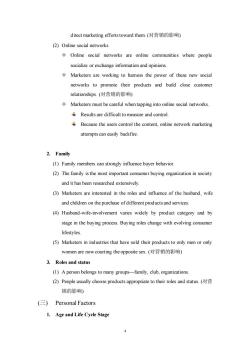
direct marketing efforts toward them.(对营销的影响) (2)Online social networks Online social networks are online communities where people socialize or exchange information and opinions. Marketers are working to hamess the power of these new social networks to promote their products and build close customer relationships.(对营销的影响) Marketers must be careful when tapping into online social networks. Results are difficult to measure and control. Because the users control the content,online network marketing attempts can easily backfire. 2.Family (1)Family members can strongly influence buyer behavior (2)The family is the most important consumer buying organization in society and it has been researched extensively. (3)Marketers are interested in the roles and influence of the husband,wife and children on the purchase of different products and services (4)Husband-wife-involvement varies widely by product category and by stage in the buying process.Buying roles change with evolving consumer lifestyles (5)Marketers in industries that have sold their products to only men or only women are now courting the opposite sex,.(对营销的影响) 3.Roles and status (1)A person belongs to many groups-family,club,organizations. (2)People usually choose products appropriate to their roles and status.( 销的影响) ()Personal Factors 1.Age and Life Cycle Stage
4 direct marketing efforts toward them. (对营销的影响) (2) Online social networks Online social networks are online communities where people socialize or exchange information and opinions. Marketers are working to harness the power of these new social networks to promote their products and build close customer relationships. (对营销的影响) Marketers must be careful when tapping into online social networks. Results are difficult to measure and control. Because the users control the content, online network marketing attempts can easily backfire. 2. Family (1) Family members can strongly influence buyer behavior. (2) The family is the most important consumer buying organization in society and it has been researched extensively. (3) Marketers are interested in the roles and influence of the husband, wife and children on the purchase of different products and services. (4) Husband-wife-involvement varies widely by product category and by stage in the buying process. Buying roles change with evolving consumer lifestyles. (5) Marketers in industries that have sold their products to only men or only women are now courting the opposite sex. (对营销的影响) 3. Roles and status (1) A person belongs to many groups—family, club, organizations. (2) People usually choose products appropriate to their roles and status. (对营 销的影响) (三) Personal Factors 1. Age and Life Cycle Stage

(1)People change the goods and services they buy over their lifetimes. (2)Marketers are increasingly catering to a growing number of altemative, nontraditional stages.(对营销的影响) 2.Occupation (1)A person's occupation affects the goods and services bought. (2)Marketers try to identify the occupational groups that have an above-average interest in their products and services.A company can even specialize in making products needed by a given occupational group. 3.Economic Situation (1)Aperson's economic situation will affect product choice (2)Marketers of income-sensitive goods watch trends in personal income, savings and interest rates. 4.Lifestyle (1)People coming from the same subculture,social class and occupation may have quite different lifestyles. (2)Life style is a person's pattern of living as expressed in his or her psychographics-activities,interests,opinions. (3)When used carefully,the lifestyle concept can help marketers understand changing consumer values and how they affect buying behavior. Consumers don't just buy products,they buy the values and lifestyles those products represent.(对营销的影响) 5.Personality and Self-concept (1)Personality is usually described in terms of traits such as self-confidence. dominance,sociability,autonomy,defensiveness,adapt ability and aggressiveness. (2)Most well-known brands are strongly associated with one particular trait. (3)Many marketers use a concept related to personality-a person's self-concept.In order to understand consumer behavior,the marketer must first understand the relationship between consumer self-concept and possessions
5 (1) People change the goods and services they buy over their lifetimes. (2) Marketers are increasingly catering to a growing number of alternative, nontraditional stages. (对营销的影响) 2. Occupation (1) A person’s occupation affects the goods and services bought. (2) Marketers try to identify the occupational groups that have an above-average interest in their products and services. A company can even specialize in making products needed by a given occupational group. 3. Economic Situation (1) A person’s economic situation will affect product choice. (2) Marketers of income-sensitive goods watch trends in personal income, savings and interest rates. 4. Lifestyle (1) People coming from the same subculture, social class and occupation may have quite different lifestyles. (2) Life style is a person’s pattern of living as expressed in his or her psychographics—activities, interests, opinions. (3) When used carefully, the lifestyle concept can help marketers understand changing consumer values and how they affect buying behavior. Consumers don’t just buy products, they buy the values and lifestyles those products represent. (对营销的影响) 5. Personality and Self-concept (1) Personality is usually described in terms of traits such as self-confidence, dominance, sociability, autonomy, defensiveness, adapt ability and aggressiveness. (2) Most well-known brands are strongly associated with one particular trait. (3) Many marketers use a concept related to personality—a person’s self-concept. In order to understand consumer behavior, the marketer must first understand the relationship between consumer self-concept and possessions
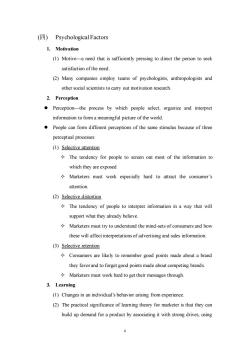
(Psychological Factors 1.Motivation (1)Motive-a need that is sufficiently pressing to direct the person to seek satisfaction of the need. (2)Many companies employ teams of psychologists,anthropologists and other social scientists to carry out motivation research. 2.Perception Perception-the process by which people select,organize and interpret information to form a meaningful picture of the world. People can form different perceptions of the same stimulus because of three perceptual processes: (1)Selective attention The tendency for people to screen out most of the information to which they are exposed Marketers must work especially hard to attract the consumer's attention. (2)Selective distortion The tendency of people to interpret information in a way that will support what they already believe. Marketers must try to understand the mind-sets of consumers and how these will affect interpretations of advertising and sales information. (3)Selective retention Consumers are likely to remember good points made about a brand they favor and to forget good points made about competing brands. Marketers must work hard to get their messages through 3.Learning (1)Changes in an individual's behavior arising from experience. (2)The practical significance of leaming theory for marketer is that they can build up demand for a product by associating it with strong drives,using 6
6 (四) Psychological Factors 1. Motivation (1) Motive—a need that is sufficiently pressing to direct the person to seek satisfaction of the need. (2) Many companies employ teams of psychologists, anthropologists and other social scientists to carry out motivation research. 2. Perception ⚫ Perception—the process by which people select, organize and interpret information to form a meaningful picture of the world. ⚫ People can form different perceptions of the same stimulus because of three perceptual processes: (1) Selective attention The tendency for people to screen out most of the information to which they are exposed Marketers must work especially hard to attract the consumer’s attention. (2) Selective distortion The tendency of people to interpret information in a way that will support what they already believe. Marketers must try to understand the mind-sets of consumers and how these will affect interpretations of advertising and sales information. (3) Selective retention Consumers are likely to remember good points made about a brand they favor and to forget good points made about competing brands. Marketers must work hard to get their messages through. 3. Learning (1) Changes in an individual’s behavior arising from experience. (2) The practical significance of learning theory for marketer is that they can build up demand for a product by associating it with strong drives, using
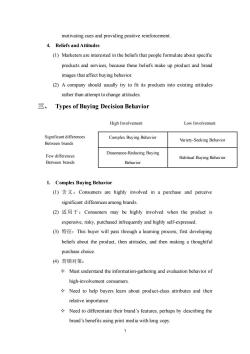
motivating cues and providing positive reinforcement. 4.Beliefs and Attitudes (1)Marketers are interested in the beliefs that people formulate about specific products and services,because these beliefs make up product and brand images that affect buying behavior. (2)A company should usually try to fit its products into existing attitudes rather than attempt to change attitudes. 三、 Types of Buying Decision Behavior High Involvement Low Involvement Significant differences Complex Buying Behavior Variety-Seeking Behavior Between brands Few differences Dissonance-Reducing Buying Habitual Buying Behavio Between brands Behavior 1.Complex Buying Behavior (I)含义:Consumers are highly involved in a purchase and perceive significant differences among brands. (2)i适用于:Consumers may be highly involved when the product is expensive,risky,purchased infrequently and highly self-expressed. (3):This buyer will pass through a learning process,first developing beliefs about the product,then attitudes,and then making a thoughtful purchase choice. (4)营销对策: Must understand the information-gathering and evaluation behavior of high-involvement consumers. Need to help buyers leam about product-class attributes and their relative importance. Need to differentiate their brand's features,perhaps by describing the brand's benefits using print media with long copy
7 motivating cues and providing positive reinforcement. 4. Beliefs and Attitudes (1) Marketers are interested in the beliefs that people formulate about specific products and services, because these beliefs make up product and brand images that affect buying behavior. (2) A company should usually try to fit its products into existing attitudes rather than attempt to change attitudes. 三、 Types of Buying Decision Behavior Complex Buying Behavior Variety-Seeking Behavior Dissonance-Reducing Buying Behavior Habitual Buying Behavior 1. Complex Buying Behavior (1) 含义:Consumers are highly involved in a purchase and perceive significant differences among brands. (2) 适用于:Consumers may be highly involved when the product is expensive, risky, purchased infrequently and highly self-expressed. (3) 特征:This buyer will pass through a learning process, first developing beliefs about the product, then attitudes, and then making a thoughtful purchase choice. (4) 营销对策: Must understand the information-gathering and evaluation behavior of high-involvement consumers. Need to help buyers learn about product-class attributes and their relative importance. Need to differentiate their brand’s features, perhaps by describing the brand’s benefits using print media with long copy. High Involvement Low Involvement Significant differences Between brands Few differences Between brands
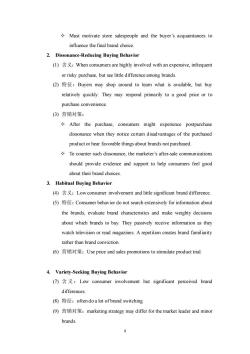
Must motivate store salespeople and the buyer's acquaintances to influence the final brand choice. 2.Dissonance-Reducing Buying Behavior (1):When consumers are highly involved with an expensive,infrequent or risky purchase,but see little difference among brands. (2)特征:Buyers may shop around to leamn what is available,.but buy relatively quickly.They may respond primarily to a good price or to purchase convenience. (3)营销对策: After the purchase.consumers might experience postpurchase dissonance when they notice certain disadvantages of the purchased product or hear favorable things about brands not purchased. To counter such dissonance,the marketer's after-sale communications should provide evidence and support to help consumers feel good about their brand choices. 3.Habitual Buying Behavior (4):Low consumer involvement and little significant brand difference. (⑤)特征:Consumer behavior do not search extensively for information about the brands,evaluate brand characteristics and make weighty decisions about which brands to buy.They passively receive information as they watch television or read magazines.A repetition creates brand familiarity rather than brand conviction (6)营销对策:Use price and sales promotions to stimulate product trial. 4.Variety-Seeking Buying Behavior (T)含义:Low consumer involvement but significant perceived brand differences. (8)特征:often doa lot of brand switching (9)营销对策:marketing strategy may differ for the market leader and minor brands
8 Must motivate store salespeople and the buyer’s acquaintances to influence the final brand choice. 2. Dissonance-Reducing Buying Behavior (1) 含义:When consumers are highly involved with an expensive, infrequent or risky purchase, but see little difference among brands. (2) 特征:Buyers may shop around to learn what is available, but buy relatively quickly. They may respond primarily to a good price or to purchase convenience. (3) 营销对策: After the purchase, consumers might experience postpurchase dissonance when they notice certain disadvantages of the purchased product or hear favorable things about brands not purchased. To counter such dissonance, the marketer’s after-sale communications should provide evidence and support to help consumers feel good about their brand choices. 3. Habitual Buying Behavior (4) 含义:Low consumer involvement and little significant brand difference. (5) 特征:Consumer behavior do not search extensively for information about the brands, evaluate brand characteristics and make weighty decisions about which brands to buy. They passively receive information as they watch television or read magazines. A repetition creates brand familiarity rather than brand conviction. (6) 营销对策:Use price and sales promotions to stimulate product trial. 4. Variety-Seeking Buying Behavior (7) 含义: Low consumer involvement but significant perceived brand differences. (8) 特征:often do a lot of brand switching (9) 营销对策:marketing strategy may differ for the market leader and minor brands
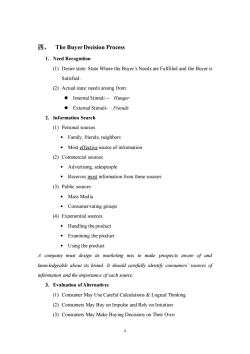
四、The Buyer Decision Process 1.Need Recognition (1)Desire state:State Where the Buyer's Needs are Fulfilled and the Buyer is Satisfied. (2)Actual state:needs arising from: Intemal Stimuli-Hunger External Stimuli-Friends 2.Information Search (1)Personal sources .Family,friends,neighbors Most effective source of information (2)Commercial sources .Advertising.salespeople Receives most information from these sources (3)Public sources ·Mass Media Consumer-rating groups (4)Experiential sources ·Handling the product ·Examining the product ·Using the product A company must design its marketing mix to make prospects aware of and knowledgeable about its brand.It should carefully identify consumers'sources of information and the importance of each source. 3.Evaluation of Alternatives (1)Consumer May Use Careful Calculations&Logical Thinking (2)Consumers May Buy on Impulse and Rely on Intuition (3)Consumers May Make Buying Decisions on Their Own
9 四、 The Buyer Decision Process 1. Need Recognition (1) Desire state: State Where the Buyer’s Needs are Fulfilled and the Buyer is Satisfied. (2) Actual state: needs arising from: ⚫ Internal Stimuli – Hunger ⚫ External Stimuli- Friends 2. Information Search (1) Personal sources • Family, friends, neighbors • Most effective source of information (2) Commercial sources • Advertising, salespeople • Receives most information from these sources (3) Public sources • Mass Media • Consumer-rating groups (4) Experiential sources • Handling the product • Examining the product • Using the product A company must design its marketing mix to make prospects aware of and knowledgeable about its brand. It should carefully identify consumers’ sources of information and the importance of each source. 3. Evaluation of Alternatives (1) Consumer May Use Careful Calculations & Logical Thinking (2) Consumers May Buy on Impulse and Rely on Intuition (3) Consumers May Make Buying Decisions on Their Own

(4)Consumers May Make Buying Decisions Only After Consulting Others. Marketers Must Study Buyers to Find Out How They Evaluate Brand Alternatives 4.Purchase Decision (1)Purchase Intention:Desire to buy the most preferred brand ·AttitudesofOthers .Unexpected Situational Factors (2)Purchase Decision 5.Postpurchase Behavior (1)The marketer's job does not end when the product is bought (2)Customer satisfaction is a key to building profitable relationships with consumers-to keeping and growing consumers and reaping their customer lifetime value. (3)Marketers go beyond merely meeting the expectations of customers-they aim to delight the customer (4)A company should measure customer satisfaction regularly.It should set up systems that encourage customers to complain.In this way,the company can leam how well it is doing and how it can improve. By studying the overall buver decision,marketers mav be able to find ways to help consumers move through it. Discussing Applying the Concepts 1.Name and describe the types of consumer buying behavior.Which one would you most likely use if deciding on a laptop computer purchase and which for picking a restaurant for dinner? 2.Explain the stages of the consumer buyer decision process and describe how you or your family went through this process to make a recent purchase. 3.Marketers often target consumers before,during or after a trigger event,an event in one's life that trigger change.For example,after having a child,new parents have an increased need for baby furniture,clothes,diapers,car seats 0
10 (4) Consumers May Make Buying Decisions Only After Consulting Others. Marketers Must Study Buyers to Find Out How They Evaluate Brand Alternatives 4. Purchase Decision (1) Purchase Intention: Desire to buy the most preferred brand • Attitudes of Others • Unexpected Situational Factors (2) Purchase Decision 5. Postpurchase Behavior (1) The marketer’s job does not end when the product is bought. (2) Customer satisfaction is a key to building profitable relationships with consumers—to keeping and growing consumers and reaping their customer lifetime value. (3) Marketers go beyond merely meeting the expectations of customers—they aim to delight the customer. (4) A company should measure customer satisfaction regularly. It should set up systems that encourage customers to complain. In this way, the company can learn how well it is doing and how it can improve. 总结:By studying the overall buyer decision, marketers may be able to find ways to help consumers move through it. Discussing & Applying the Concepts 1. Name and describe the types of consumer buying behavior. Which one would you most likely use if deciding on a laptop computer purchase and which for picking a restaurant for dinner? 2. Explain the stages of the consumer buyer decision process and describe how you or your family went through this process to make a recent purchase. 3. Marketers often target consumers before, during or after a trigger event, an event in one’s life that trigger change. For example, after having a child, new parents have an increased need for baby furniture, clothes, diapers, car seats
按次数下载不扣除下载券;
注册用户24小时内重复下载只扣除一次;
顺序:VIP每日次数-->可用次数-->下载券;
- 《市场营销学》课程授课教案(双语)Chapter 4 Managing Marketing Information to Gain Customer Insights.doc
- 《市场营销学》课程授课教案(双语)Chapter 2 Company and Marketing Strategy.doc
- 《市场营销学》课程授课教案(双语)Chapter 11 Communicating Customer Value.doc
- 《市场营销学》课程授课教案(双语)Chapter 8 Products, Services, and Brands.doc
- 《市场营销学》课程授课教案(双语)Chapter 7 Customer-Driven Marketing Strategy.doc
- 《市场营销学》课程授课教案(双语)Chapter 6 Business Markets and Business Buyer Behavior.doc
- 《市场营销学》课程授课教案(双语)Chapter 9 Pricing and Pricing Strategies.doc
- 《市场营销学》课程授课教案(双语)Chapter 10 Marketing Channels.doc
- 内蒙古科技大学:《市场营销学》课程授课教案(中文)第1章 营销与营销过程.doc
- 内蒙古科技大学:《市场营销学》课程授课教案(中文)第3章 营销系统与营销环境分析.doc
- 内蒙古科技大学:《市场营销学》课程授课教案(中文)第4章 消费者市场与购买行为分析.doc
- 内蒙古科技大学:《市场营销学》课程授课教案(中文)第2章 顾客价值与顾客满意.doc
- 内蒙古科技大学:《市场营销学》课程授课教案(中文)第9章 市场传播与促销.doc
- 内蒙古科技大学:《市场营销学》课程授课教案(中文)第10章 产品生命周期与营销战略.doc
- 内蒙古科技大学:《市场营销学》课程授课教案(中文)第6章 产品决策.doc
- 内蒙古科技大学:《市场营销学》课程授课教案(中文)第5章 市场细分、决定目标市场与定位.doc
- 内蒙古科技大学:《市场营销学》课程授课教案(中文)第7章 价格策略.doc
- 内蒙古科技大学:《市场营销学》课程授课教案(中文)第8章 分销管理.doc
- 内蒙古科技大学:《市场营销学》课程教学资源(试卷习题)2013-2014第二学期试卷A(答案).doc
- 内蒙古科技大学:《市场营销学》课程教学资源(试卷习题)2013-2014第二学期试卷A(试题).doc
- 《市场营销学》课程授课教案(双语)Chapter 3 Analyzing the Marketing Environment.doc
- 《市场营销学》课程授课教案(双语)Chapter 1 Marketing.doc
- 《市场营销学》课程教学案例(中文)第8章案例 分销渠道策略-通用公司打造全球供应链.doc
- 《市场营销学》课程教学案例(中文)第9章案例 促销策略-中国肥皂泡戏煞东瀛人.doc
- 《市场营销学》课程教学案例(中文)第6章案例 产品决策-广东太阳神的产品组合.doc
- 《市场营销学》课程教学案例(中文)第7章案例 价格决策-海信空调的价格策略.doc
- 《市场营销学》课程教学案例(中文)第5章案例 市场细分、决定目标市场与定位- “红高粱”的启示.doc
- 《市场营销学》课程教学案例(中文)第3章案例 市场营销环境-恒伟药业信息调研出效益.doc
- 《市场营销学》课程教学案例(中文)第4章案例 分析消费者市场与购买行为-小阿华的“精确营销”.doc
- 《市场营销学》课程教学案例(中文)第2章案例 规划企业战略与市场营销管理-雅戈尔,选择没有对错.doc
- 《市场营销学》课程教学案例(中文)第1章案例 营销与营销管理-亚马逊名震全球之道.doc
- 《市场营销学》课程教学案例(双语)The Pepsi and Coca-Cola Challenge-A Cola with Breakfast.doc
- 《市场营销学》课程教学案例(双语)Van Der Steen Candy Company.doc
- 《市场营销学》课程教学案例(双语)Summit Ski Produc.doc
- 《市场营销学》课程教学案例(双语)Who will go to Saudi Arabia.doc
- 《市场营销学》课程教学案例(双语)Egle Steel Supply Company.doc
- 《市场营销学》课程教学案例(双语)Selling Whoppers In Japan.doc
- 内蒙古科技大学:《市场营销学》课程作业习题(分章)市场营销学练习及答案(共九章).doc
- 内蒙古科技大学:《市场营销学》课程作业习题(综合)综合习题九.doc
- 内蒙古科技大学:《市场营销学》课程作业习题(综合)综合习题九答案.doc
